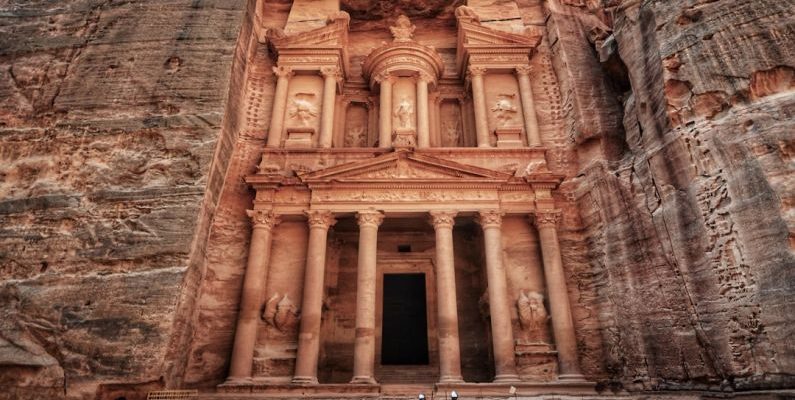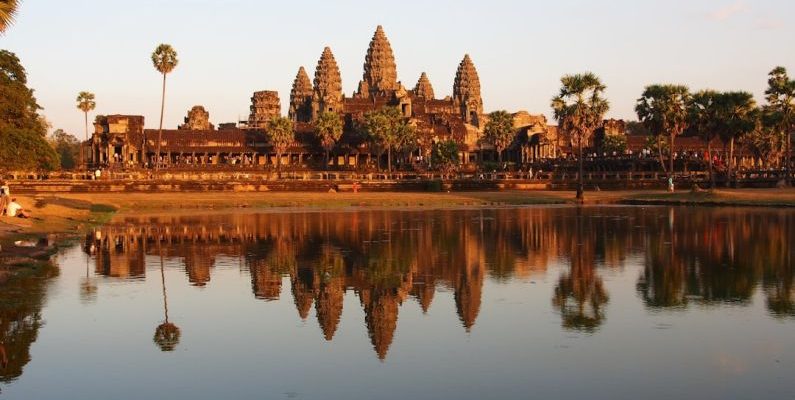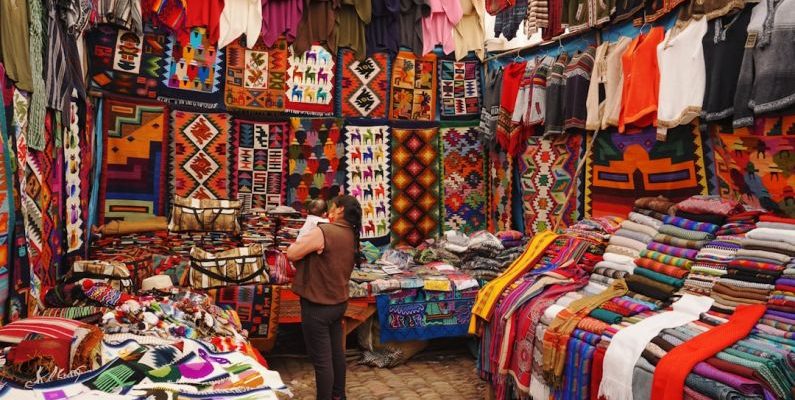Nestled within the vibrant cityscape of Hong Kong lies a culinary treasure trove that beckons both locals and travelers alike: the world of dim sum. A traditional Cantonese cuisine that has captivated taste buds around the globe, dim sum in Hong Kong is an experience like no other. From the bustling streets of Mong Kok to the upscale dining establishments in Central, feasting on dim sum in Hong Kong is a gastronomic adventure that promises to delight and surprise even the most discerning palates.
Author: vview
Native American tribes have a rich and diverse history that spans thousands of years. These indigenous peoples have inhabited the land now known as the United States long before European settlers arrived. The history and culture of Native American tribes are deeply intertwined with the land, traditions, and values that have been passed down through generations.
Origins and Migration
The history of Native American tribes in North America dates back thousands of years. It is believed that the first indigenous peoples migrated to the continent from Asia over a land bridge that once connected Siberia to Alaska during the last Ice Age. These early settlers spread out across the land, establishing distinct tribes with their own languages, customs, and territories.Diverse Cultures and Traditions
There is great diversity among Native American tribes, each with its own unique culture and traditions. From the Navajo in the Southwest to the Inuit in the Arctic, these tribes have developed distinct ways of life shaped by their environment and experiences. Traditional practices such as storytelling, dance, and art play a significant role in preserving the cultural heritage of these indigenous peoples.Spirituality and Connection to the Land
Spirituality is a central aspect of Native American culture, with many tribes holding deep reverence for the natural world and their ancestors. Traditional beliefs often center around the idea of interconnectedness between all living beings and the importance of living in harmony with the land. Ceremonies and rituals are performed to honor the spirits and seek guidance from the divine forces that govern the universe.Impact of European Colonization
The arrival of European colonizers in the Americas had a profound impact on Native American tribes. Forced removal from their ancestral lands, disease, and warfare led to the decimation of indigenous populations and the loss of traditional ways of life. Many tribes were forced to assimilate into European culture or relocate to reservations, disrupting their social structures and spiritual practices.Resilience and Cultural Revival
Despite centuries of colonization and oppression, Native American tribes have shown remarkable resilience in preserving their cultural heritage. Efforts to revitalize traditional languages, ceremonies, and art forms have helped to keep alive the rich traditions of these indigenous peoples. Organizations and individuals dedicated to cultural preservation work tirelessly to ensure that future generations can continue to celebrate and honor their Native heritage.Challenges and Opportunities
While progress has been made in recent years to recognize and support Native American communities, many challenges still remain. Issues such as poverty, healthcare disparities, and environmental degradation continue to impact indigenous populations across the country. However, there are also opportunities for positive change, with increasing awareness and support for Native rights and sovereignty.Looking to the Future
As we reflect on the history and culture of Native American tribes, it is important to acknowledge the resilience, strength, and diversity of these indigenous peoples. By honoring their traditions, advocating for their rights, and supporting their communities, we can help ensure a brighter future for Native Americans and preserve the rich tapestry of their heritage for generations to come.
In Solo Travel
Embarking on a solo travel journey can be one of the most empowering experiences a person can have. It offers a unique opportunity for self-discovery, personal growth, and building confidence. While traveling alone may seem daunting at first, the benefits it brings far outweigh any initial apprehensions. In this article, we will explore how solo travel can help individuals boost their confidence and why it is an essential experience for personal development.
Embracing Independence
Solo travel forces individuals to step out of their comfort zones and embrace independence. When you are on your own in a foreign land, you are solely responsible for navigating through unfamiliar territory, making decisions, and solving problems that arise along the way. This newfound independence allows you to rely on your own capabilities and resourcefulness, building a sense of self-reliance that translates into increased confidence in your everyday life.Navigating Challenges
Traveling solo presents a myriad of challenges, from language barriers to getting lost in a new city. However, overcoming these obstacles serves as a powerful confidence booster. Each challenge successfully navigated reinforces your ability to adapt, problem-solve, and think on your feet. As you conquer these hurdles, you develop a sense of resilience that empowers you to tackle obstacles with confidence both during your travels and in your personal and professional life.Cultural Immersion
One of the most enriching aspects of solo travel is the opportunity to immerse yourself in different cultures. Stepping out of your comfort zone and experiencing new ways of life broadens your perspective and fosters a greater understanding of the world around you. Engaging with locals, trying unfamiliar foods, and exploring unique customs not only enrich your travel experience but also boost your self-assurance by proving your ability to adapt to diverse environments.Self-Discovery
Solo travel provides a conducive environment for self-reflection and introspection. Removed from the distractions of everyday life, you have the opportunity to delve deep into your thoughts, desires, and aspirations. This introspective journey allows you to gain a better understanding of yourself, your values, and what truly matters to you. Through self-discovery, you cultivate a stronger sense of self-awareness and self-acceptance, which are foundational pillars of confidence.Building Social Skills
While solo travel may seem solitary, it often leads to unexpected social encounters. Whether connecting with fellow travelers, striking up conversations with locals, or joining group activities, solo travelers are pushed out of their comfort zones to interact with others. These social interactions not only enhance the travel experience but also sharpen communication skills, foster empathy, and boost self-assurance in social settings. Over time, the ability to initiate and navigate social interactions confidently becomes second nature.Overcoming Fear and Uncertainty
Fear and uncertainty are common emotions that accompany solo travel, especially for first-time solo travelers. However, facing these fears head-on and pushing past your comfort zone is a transformative experience. By navigating the unknown, overcoming obstacles, and adapting to unexpected situations, you prove to yourself that you are capable of handling challenges with grace and resilience. Each fear conquered becomes a stepping stone towards greater self-assurance and a belief in your ability to thrive in the face of uncertainty.Embracing Change and Growth
Solo travel is a catalyst for personal growth and transformation. It pushes you to embrace change, step outside your comfort zone, and challenge your preconceived limitations. Through the experiences and lessons gained while traveling solo, you not only build confidence but also cultivate a growth mindset that propels you towards continuous self-improvement. Embracing change and uncertainty becomes less daunting as you realize your capacity to adapt and thrive in new and unfamiliar circumstances.Discovering Strength in Vulnerability
Vulnerability is often seen as a weakness, yet solo travel teaches us that there is strength in vulnerability. Opening yourself up to new experiences, people, and challenges requires a level of vulnerability that fosters authentic connections and personal growth. By embracing vulnerability, you cultivate a deeper sense of self-assurance rooted in authenticity and resilience. This newfound strength allows you to approach life with courage, empathy, and a willingness to embrace the unknown.Embracing Your Inner Strength
Solo travel is not just about exploring the world; it is about embarking on a journey of self-discovery, personal growth, and building confidence. By embracing independence, navigating challenges, immersing yourself in different cultures, and overcoming fears, you unlock your inner strength and unleash your full potential. Through solo travel, you learn to trust yourself, embrace change, and face the unknown with confidence and resilience. So, pack your bags, step out of your comfort zone, and embark on a solo travel adventure that will not only broaden your horizons but also empower you to embrace your inner strength and confidence.
In Eco-Tourism
Traveling is a wonderful way to explore new cultures, landscapes, and experiences. However, as more people travel around the world, it is essential to consider the impact of tourism on the environment and biodiversity. Responsible travel is a growing trend that focuses on minimizing negative impacts and promoting sustainability. By making conscious choices while traveling, individuals can help protect biodiversity and support local communities.
Preserving Natural Habitats
One of the key ways responsible travel promotes biodiversity is by supporting the preservation of natural habitats. Many popular travel destinations are home to unique ecosystems and endangered species. By choosing to visit protected areas and wildlife reserves, travelers can contribute to conservation efforts and help protect biodiversity. Supporting eco-friendly accommodations and tour operators that prioritize sustainability also plays a crucial role in preserving natural habitats.Respecting Wildlife
Responsible travel involves respecting wildlife and observing animals in their natural environments without causing harm or disruption. Activities such as wildlife viewing, snorkeling, and birdwatching can provide unforgettable experiences while promoting biodiversity conservation. It is essential to follow guidelines set by conservation organizations and local authorities to ensure that interactions with wildlife are ethical and sustainable.Supporting Local Communities
Another important aspect of promoting biodiversity through responsible travel is supporting local communities. By choosing to stay in locally-owned accommodations, eating at small restaurants, and purchasing souvenirs from local artisans, travelers can contribute to the economic development of the places they visit. Investing in community-based tourism initiatives helps empower local people and provides alternative livelihoods that are less harmful to the environment.Reducing Carbon Footprint
Traveling often involves transportation methods that contribute to carbon emissions and climate change. To minimize their carbon footprint, responsible travelers can opt for eco-friendly modes of transportation such as trains, buses, or bicycles whenever possible. Offsetting carbon emissions through reputable programs can also help mitigate the environmental impact of travel. Additionally, choosing accommodations that prioritize energy efficiency and waste reduction further supports biodiversity conservation efforts.Promoting Sustainable Practices
Responsible travel encourages individuals to adopt sustainable practices that minimize waste and conserve resources. Simple actions such as using reusable water bottles, shopping with eco-friendly bags, and avoiding single-use plastics can make a significant difference in reducing environmental pollution. Participating in beach clean-ups, tree planting initiatives, or wildlife monitoring programs are also effective ways to contribute to biodiversity conservation while traveling.Engaging in Responsible Tourism Activities
Many destinations offer opportunities for responsible tourism activities that promote biodiversity conservation and environmental education. Travelers can participate in guided nature walks, volunteer programs, or cultural exchanges that support local conservation projects. Learning about the flora and fauna of a region from knowledgeable guides and scientists enhances the travel experience while fostering a deeper appreciation for biodiversity.Embracing Sustainable Tourism Principles
In conclusion, promoting biodiversity through responsible travel is a collective effort that requires individuals to embrace sustainable tourism principles. By making informed choices, respecting nature, supporting local communities, and reducing their environmental impact, travelers can play a vital role in conserving biodiversity for future generations. Responsible travel not only enriches the travel experience but also contributes to the preservation of our planet's natural heritage. Let's embark on journeys that not only inspire us but also protect the diversity of life on Earth.
In Travel Tips
Traveling to foreign countries is an exciting adventure that allows you to immerse yourself in new cultures, explore new sights, and broaden your horizons. One of the essential aspects of navigating a new city or country is mastering the public transportation system. While it may seem daunting at first, with a little bit of preparation and knowledge, you can confidently navigate public transport in any foreign country like a pro.
Research and Planning
Before embarking on your journey, take the time to research the public transportation options available in the country you will be visiting. Familiarize yourself with the types of transportation systems, such as buses, trains, trams, and subways, that are commonly used in that particular location. Understanding the routes, schedules, and ticketing systems will help you navigate the public transport network with ease.Apps and Online Resources
In this digital age, there are numerous apps and online resources available to assist you in mastering public transport in foreign countries. Downloading transportation apps specific to the country you are visiting can provide real-time information on routes, schedules, and even delays. Additionally, websites like Google Maps offer detailed public transport directions, making it easy to plan your journey in advance.Language Tools
Language barriers can often be a hindrance when using public transport in foreign countries. To overcome this challenge, consider using language translation apps or carrying a pocket dictionary with common phrases related to public transportation. Learning a few key words or phrases in the local language, such as "ticket," "bus stop," or "train station," can go a long way in communicating with locals and navigating the transport system more effectively.Navigating Ticketing Systems
Ticketing systems for public transport can vary widely from country to country, so it's essential to understand how to purchase and validate tickets before boarding. Some countries may require you to buy tickets in advance from kiosks or ticket booths, while others may allow you to pay directly to the driver or conductor. Be sure to familiarize yourself with the local currency and have small denominations of cash on hand to purchase tickets easily.Observing Local Etiquette
Each culture has its own set of norms and etiquette when it comes to using public transport. Observing and respecting these customs can help you avoid any misunderstandings or unintentional faux pas. For example, in some countries, it is customary to offer your seat to elderly or pregnant passengers, while in others, talking loudly on public transport may be considered rude. Pay attention to the behavior of locals and follow suit to ensure a smooth and respectful journey.Safety and Security
While public transport is generally a safe mode of transportation, it's essential to remain vigilant and mindful of your surroundings, especially in unfamiliar environments. Keep your belongings close to you and be wary of pickpockets in crowded areas. If traveling late at night, consider opting for well-lit and populated transport options or arranging for a reputable taxi service to ensure your safety.Adapting to Unforeseen Circumstances
Despite careful planning, unforeseen circumstances such as delays, strikes, or route changes can occur when using public transport in foreign countries. In such situations, it's important to stay calm and flexible, seeking assistance from transport staff or fellow passengers if needed. Having a backup plan or alternative routes in mind can help you navigate unexpected disruptions and reach your destination smoothly.Mastering Public Transport with Confidence
By arming yourself with knowledge, preparation, and a sense of adventure, mastering public transport in foreign countries can become a seamless and rewarding experience. Embrace the opportunity to explore new modes of transportation, interact with locals, and discover hidden gems off the beaten path. With a positive attitude and a willingness to adapt, you can confidently navigate any public transport system, making the most of your travel adventures abroad.
In Eco-Tourism
In a world where countless species are on the brink of extinction due to various human-induced factors, the role of tourism in conservation efforts has become increasingly significant. By harnessing the power of tourism, we have the opportunity to protect and preserve endangered species while also fostering sustainable and responsible travel practices.
The Impact of Tourism on Endangered Species
Tourism, when managed effectively, can have a positive impact on endangered species and their habitats. When tourists visit protected areas or wildlife reserves, they contribute to the local economy through entrance fees, accommodations, and other tourism-related expenditures. These financial contributions can be channeled back into conservation efforts, such as anti-poaching patrols, habitat restoration, and community education programs. Additionally, the presence of tourists in these areas can act as a deterrent to poachers and illegal wildlife traffickers. Increased human activity and vigilance provided by tourists and park rangers can help safeguard endangered species from exploitation and harm.Promoting Conservation Awareness
One of the most significant benefits of tourism in protecting endangered species is its ability to raise awareness and promote conservation efforts on a global scale. When tourists have the opportunity to observe and learn about endangered species in their natural habitats, they develop a deeper appreciation for the importance of conservation. Guided tours, educational programs, and interpretive signage in protected areas can inform visitors about the threats facing endangered species and the actions being taken to protect them. By engaging with tourists and sharing information about conservation challenges, local communities and conservation organizations can inspire visitors to become advocates for endangered species and support conservation initiatives.Creating Economic Incentives for Conservation
Tourism can provide economic incentives for local communities to prioritize conservation over destructive land uses. By showcasing the value of wildlife and natural habitats as tourist attractions, communities can shift away from unsustainable practices such as logging, mining, or agriculture that threaten endangered species and their habitats. Eco-tourism initiatives that promote responsible travel practices and sustainable tourism development can help ensure that local communities benefit from conservation efforts. By involving communities in tourism planning and management, conservation organizations can create economic opportunities that support both people and wildlife.Supporting Research and Monitoring Efforts
Tourism can also play a crucial role in supporting research and monitoring efforts aimed at better understanding and conserving endangered species. Tourists who participate in wildlife tours or research expeditions can contribute valuable data through citizen science initiatives, such as identifying individual animals, recording behaviors, or monitoring population trends. By engaging tourists in scientific research and monitoring activities, conservation organizations can enhance their capacity to collect data, track species populations, and assess the effectiveness of conservation interventions. This collaborative approach not only benefits endangered species but also provides visitors with a unique and meaningful experience that fosters a sense of stewardship and connection to the natural world.Empowering Local Communities
Empowering local communities to take an active role in wildlife conservation is essential for the long-term protection of endangered species. Tourism can provide opportunities for communities to participate in conservation initiatives, develop sustainable livelihoods, and build capacity for managing natural resources. By involving local communities in ecotourism ventures, conservation organizations can create partnerships that benefit both wildlife and people. Community-based tourism projects that offer cultural experiences, homestays, and traditional crafts can diversify local economies and reduce dependence on activities that harm endangered species. In conclusion, tourism has the potential to be a powerful tool for protecting endangered species and their habitats. By harnessing the economic, educational, and research benefits of tourism, we can create a sustainable future where humans and wildlife coexist harmoniously. Through responsible travel practices and conservation-focused tourism initiatives, we can make a positive impact on the preservation of endangered species for generations to come.
Nestled in the rugged desert terrain of southern Jordan, the ancient city of Petra stands as a testament to human ingenuity and architectural prowess. Known as the "Rose City" due to the rosy hue of its rock-cut structures, Petra is a historical marvel that continues to captivate visitors from around the world. From its mysterious origins to its eventual rediscovery by the Western world, Petra's allure lies not only in its breathtaking beauty but also in the enigmatic stories that shroud its past.
**Unveiling the Mysteries of Petra**
The history of Petra dates back to the 4th century BC when it was established as the capital of the Nabatean Kingdom. The Nabateans, an ancient Arab civilization, harnessed the natural beauty of the surrounding landscape to carve elaborate buildings and tombs into the rose-colored sandstone cliffs. The city flourished as a vital hub for trade, connecting the Arabian Peninsula, Egypt, and the Mediterranean region.
**The Iconic Treasury**
One of the most iconic structures in Petra is the Treasury, also known as Al-Khazneh. This magnificent facade, with its intricate carvings and towering columns, has captured the imagination of travelers and explorers for centuries. Legend has it that the Treasury once held hidden treasures, hence its name. Despite numerous attempts to uncover its secrets, the Treasury remains a symbol of Petra's mystique and grandeur.
**The Siq: Gateway to Petra**
To reach the Treasury, visitors must first navigate through the Siq, a narrow gorge that winds its way through the cliffs. As sunlight filters through the towering walls, casting a warm glow on the ancient passageway, a sense of anticipation builds with each step. The Siq serves as a dramatic entrance to Petra, setting the stage for the awe-inspiring sights that lie beyond.
**The Royal Tombs and Monastery**
Beyond the Treasury, Petra reveals a treasure trove of archaeological wonders. The Royal Tombs, with their imposing facades and intricate details, stand as a testament to the wealth and power of the Nabatean rulers. Further afield, the Monastery looms large atop a hill, its massive facade carved into the rock face. The journey to reach the Monastery is arduous but rewarding, offering panoramic views of the surrounding desert landscape.
**Rediscovery and Preservation**
Despite its prominence in ancient times, Petra was eventually abandoned and fell into obscurity. It wasn't until the early 19th century that Swiss explorer Johann Ludwig Burckhardt stumbled upon the hidden city, sparking renewed interest in its history and preservation. Today, Petra is a UNESCO World Heritage Site, attracting visitors from across the globe who come to marvel at its architectural splendor and rich cultural heritage.
**Embracing the Past: Petra's Enduring Legacy**
As visitors wander through the ancient streets of Petra, they are transported back in time to an era of trade, innovation, and cultural exchange. The city's intricate carvings, elaborate temples, and grand amphitheater offer a glimpse into the vibrant life of the Nabateans and their enduring legacy. Petra serves as a poignant reminder of the resilience of human civilization and the enduring power of cultural heritage to unite and inspire.
**In Conclusion: Petra's Timeless Beauty**
In a world marked by constant change and upheaval, Petra stands as a timeless symbol of human creativity and perseverance. Its rock-cut architecture, intricate carvings, and rich history continue to captivate and inspire all who visit. As we marvel at the wonders of Petra, we are reminded of the enduring legacy of ancient civilizations and the importance of preserving our shared heritage for future generations to cherish and learn from.
Nestled in the heart of Cambodia lies a UNESCO World Heritage site that continues to captivate travelers and historians alike - Angkor Wat. This ancient temple complex, shrouded in mystery and grandeur, stands as a testament to the ingenuity and architectural prowess of the Khmer Empire. From its intricate carvings to its towering spires, Angkor Wat beckons visitors to unravel its enigmatic past and discover the secrets hidden within its walls.
The Enigmatic Origins of Angkor Wat
The construction of Angkor Wat is believed to have begun in the early 12th century during the reign of King Suryavarman II. Originally built as a Hindu temple dedicated to the god Vishnu, Angkor Wat later transformed into a Buddhist site. The shift in religious significance is a reflection of the cultural and political changes that swept through the region at that time. One of the most intriguing aspects of Angkor Wat is its alignment with astronomical phenomena. Scholars have noted that the layout of the temple complex corresponds to celestial events such as the equinoxes and solstices. This meticulous attention to astronomical detail underscores the Khmer people's deep connection to the cosmos and their sophisticated understanding of celestial mechanics.The Symbolism of Angkor Wat's Architecture
As one approaches Angkor Wat, the sheer scale and complexity of its architecture are awe-inspiring. The temple's five towers, representing Mount Meru, the mythical abode of the gods in Hindu cosmology, soar into the sky, symbolizing the link between the earthly and divine realms. The intricate bas-reliefs that adorn the walls depict scenes from Hindu epics such as the Ramayana and the Mahabharata, offering a glimpse into the religious and mythological beliefs of the Khmer civilization. The central sanctuary of Angkor Wat houses a sacred lingam, a phallic symbol representing the god Shiva, underscoring the temple's significance as a place of worship and spiritual pilgrimage. The complex layout of Angkor Wat, with its series of concentric galleries and courtyards, mirrors the cosmic order and invites contemplation on the interconnectedness of all things.Rediscovering Lost Treasures
Despite its fame and notoriety, Angkor Wat still holds many secrets waiting to be uncovered. In recent years, archaeologists have made remarkable discoveries within the temple complex, shedding new light on its history and significance. From hidden chambers to underground passages, each new find adds to the mystique surrounding Angkor Wat and challenges our understanding of this ancient marvel. One of the most significant discoveries in recent years is the identification of a vast network of canals and reservoirs surrounding Angkor Wat, highlighting the Khmer Empire's sophisticated hydraulic engineering capabilities. These water management systems not only sustained the temple complex but also facilitated agricultural productivity, enabling the empire to flourish despite the challenges of a tropical climate.Exploring the Legacy of Angkor Wat
As visitors wander through the corridors of Angkor Wat, they are transported back in time to an era of splendor and grandeur. The temple complex's enduring legacy lies not only in its architectural magnificence but also in the cultural and spiritual traditions it embodies. For the Khmer people, Angkor Wat is more than just a historical site - it is a symbol of national pride and resilience, a testament to their rich heritage and enduring spirit. Today, Angkor Wat stands as a symbol of Cambodia's cultural identity and a beacon of hope for future generations. By preserving and protecting this ancient wonder, we honor the ingenuity and creativity of the Khmer people and ensure that their legacy continues to inspire and enlighten us. In a world filled with rapid change and uncertainty, Angkor Wat stands as a reminder of the enduring power of human creativity and the timeless beauty of our shared heritage.
Cusco, once the capital of the Inca Empire, holds within its ancient stone walls and winding streets a legacy that speaks to the rich history and cultural significance of this remarkable civilization. From the awe-inspiring ruins of Sacsayhuamán to the vibrant markets of San Pedro, the spirit of the Incas is palpable in every corner of this enchanting city. Let us delve into the enduring legacy of the Incas in Cusco, Peru.








